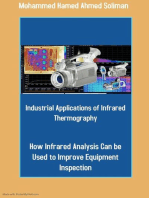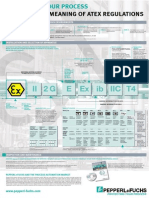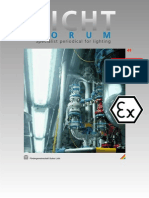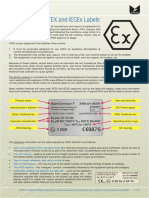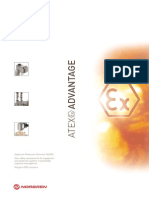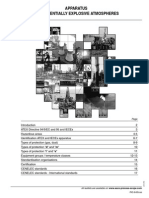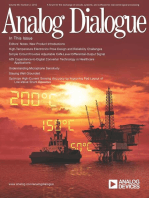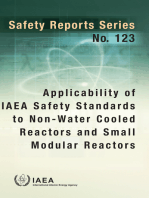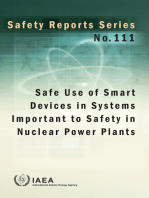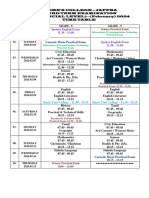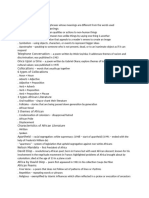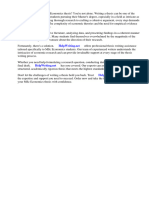ATEX Poster
ATEX Poster
Uploaded by
Juan Ramon RodriguezCopyright:
Available Formats
ATEX Poster
ATEX Poster
Uploaded by
Juan Ramon RodriguezOriginal Description:
Copyright
Available Formats
Share this document
Did you find this document useful?
Is this content inappropriate?
Copyright:
Available Formats
ATEX Poster
ATEX Poster
Uploaded by
Juan Ramon RodriguezCopyright:
Available Formats
9560 ATEX poster 05
1/2/05
11:35 am
Page 1
Wolf Safety Lamp Company
ATEX Explained
Ex Equipment
This guide is provided to aid in the selection of Wolf lighting products for use in potentially explosive atmospheres. Information given is based on practice within the EU, as specified in the requirements of the 94/9/EC ATEX (Equipment) Directive and the 99/92/EC ATEX (Workplace) Directive.
ATEX MARKING
1180
WOLFLITE HANDLAMP
H-251A
II 2 GD
GD
ATEX MARKING
CE mark denotes
manufacturers
declaration
of product
compliance to
all relevant EU
Directives
Number of
Notified Body
responsible for
EC monitoring
of production
quality
Specific
mark for
Explosion
Protection
Equipment
Group
Equipment
Category
Defines suitability
of use of Group II
equipment in gas
and/or dust
atmospheres
CERTIFICATION CODE
Battery 4V, 5Ah
type H-66 ONLY
gases, vapours & mists
CERTIFICATION CODE
Explosion Protected equipment
E prefix denotes compliance
with CENELEC Standards in
the EN50014 series
IIC
e ib
Serial/batch number
incorporating year of construction
T4
ATEX
00
Year Certificate Issued
Serial
Number
2176
ATEX Certificate
X Suffix denotes special conditions of certification
EC-TYPE EXAMINATION
CERTIFICATE NUMBER
HPR 3.75V min. 0.75A max.
1180
U Suffix denotes Ex component approval
EC NOTIFIED BODIES
MARKING FOR DUST
IGNITION PROTECTION
CE mark (ATEX marking)
Notified Bodies have been appointed by the governments of individual EC
countries as responsible to carry out part or all of the functions specified in
the ATEX Equipment Directive, such as EC type examination of equipment
and quality assurance assessment of equipment production.
to EN 50281-1-1
Supplementary approval
Lloyds Register of Shipping
marine approval
Batch No.
IP66
T135C
Ingress
Protection Code
Maximum External
Surface Temperature
Baseefa (2001) Ltd are responsible for the quality assurance assessment of
equipment manufactured by the Wolf Safety Lamp Company, this is identified
by their notified body number (1180) appearing below the CE mark on
Wolf products.
The Wolf Safety Lamp Company Ltd.
Sheffield - S8 0YA - England
Protection
Concepts
BAS
Explosion protection mark (ATEX marking)
3.6 min. 1.0A max.
Do not open or charge in Ex areas.
Charge in charger unit C-251 HV/LV ONLY.
Recharge battery immediately after use.
Ne pas charger ni ouvrir lappareil en zones Ex.
Ne recharger que sur des chargeur C-251 HV/LV.
Recharger immediatement les batteries dechargees.
Gerat nicht im Ex-Bereich laden oder ffnen.
Nur mit Ladegert typ C-251 HV/LV aufladen.
Nach Gebrauch sofort wieder aufladen.
Safety measures to be applied in service
gases, vapours and mists to EN 50014
Notified body
responsible for
EC-Type
Examination
(Test House)
MARKING FOR DUST
IGNITION PROTECTION
EEx e ib IIC T4
IP66 T135oC
BAS 00 ATEX 2176
Replacement parts specification
E Ex
EC-TYPE EXAMINATION CERTIFICATE NUMBER
Ex EQUIPMENT LABEL
II
Gas Group Temperature
Classification
Note: EEx and Protection Concepts are not marked if a Technical File
from first principles is applied.
GAS GROUP
EQUIPMENT GROUP & EQUIPMENT CATEGORY
Use
Gas Dust
M1
Very high
protection
M2
Mining
II
High
protection
Very high
protection
High
protection
Normal
protection
Industrial
Operable in Ex
atmosphere
Mining
De-energised
in Ex atmosphere
IIA
Propane
IIB
Ethylene
Zones 0,1,2,
D
Zones 20,21,22
Zones 21,22
IIC
Zones 1,2
Methane
energy required more
to ignite gas
Maximum Safe Gap
Flameproof Ex d
Hydrogen/Acetylene
Industrial
G
GROUP II GAS SUBDIVISION
Applicable
Concepts
wide
Hazard
all concepts
INGRESS PROTECTION (IP) CODE
to EN 60529
Ex equipment selection for use in gases, vapours, mists or dusts must take into consideration
the environmental conditions of the area in which it is to be used. Apparatus resistance to
ingress of both solid bodies and water is identified by use of an IP rating.
IIA
1st Numeral
Protection Against Solid Bodies
IIB
no protection
2nd Numeral
Protection Against Water
TEMPERATURE CLASS
Temperature class relates to the hot surface ignition temperature of a particular explosive
atmosphere. It must not be exceeded by the temperature classification of the equipment
intended to be used in that atmosphere.
Explosion Protected
Hot surfaces can ignite explosive atmospheres
Equipment
IIC
Ex d, Ex ia/ib
no protection
> 50mm
II
90
> 12.5mm
II
Zones 2
Ex e, Ex m, Ex p,
Ex o, Ex q, Ex n
All Gases
IIB
IIA
Explosion
Protected
Equipment
n
ignitio
Risk of
flameproof
gap size
Protection
Level
Maximum Safe
Sparking Energy
Intrinsic Safety Ex ia/ib
narrow
Equipment
Category
Typical Hazard
less
Equipment
Group
Group
Zones 22
Equipment sub-grouping segregates gases according to ease of ignitability by sparks or flames. These apply to flameproof Ex d and
intrinsically safe Ex ia/ib equipment only.
Equipment Group and Category identify the areas in which equipment may be safely used
15
IIC
tially
Poten e
iv
Explos ere
ph
Atmos
> 2.5mm
60
> 1mm
CE MARKING AND THE 94/9/EC ATEX DIRECTIVE ON EQUIPMENT
AND PROTECTIVE SYSTEMS INTENDED FOR
USE IN POTENTIALLY EXPLOSIVE ATMOSPHERES.
PROTECTION CONCEPTS FOR ELECTRICAL APPARATUS
CE marking has been introduced as part of the European Unions new approach to technical harmonisation
as a means of identifying products that comply with all relevant EC directives.
Subject to certain safeguards, products bearing the CE mark are permitted to be sold throughout the EU
without interference from national regulatory authorities. The Directives have been put in place in order to
remove artificial trade barriers within the European Union previously caused by individual countries national
standards, a secondary function is as a means of regulating safety.
The Explosive Atmospheres 94/9/EC ATEX (Equipment) Directive came into force
on 1 March 1996. The Directive is in transition, where product compliance is optional,
until 1 July 2003 when it becomes mandatory.
On this date the existing Explosive Atmospheres and Gassy Mines Directives will be
repealed. Thereafter only equipment and systems CE marked as compliant with the
ATEX Equipment Directive (and all other relevant mandatory directives) may placed on the
market within the EU.
The Directive applies to all equipment and systems for use in potentially explosive atmospheres within the EU.
The scope of the directive includes electrical and mechanical equipment for use in Group I (mining) or Group II
(industrial) applications, both on and offshore and considers risks of ignition of potentially explosive gas,
vapour, mist and dust atmospheres. In addition, devices intended for use outside potentially explosive
atmospheres that contribute to the safe functioning of equipment and systems with regard to explosion risk
are also included.
EN Standard
General requirements
EN 50014
Ex o
explosive gas excluded
by immersing ignition
source in oil
EN 50015
General req.
Oil immersion
Icon
ition
of ign
Risk
Pressurised
Ex p
explosive gas excluded
by surrounding ignition
source with pressurised
inert gas
EN 50016
Powder filled
Ex q
explosive gas excluded
by immersing ignition
source in sand
EN 50017
Ex d
Increased
safety
A common route to product design compliance is to apply to a Notified Body (Ex. Test House) for an EC
Type Examination Certificate. To comply, the equipment or system must meet the Essential Health and Safety
Requirements (EHSRs) listed in the Directive. Harmonised EU standards have been adopted by CENELEC and
CEN, relating to the design, construction and testing of equipment; a product complying with these standards
is deemed to meet the EHSRs to which the standards relate. Where apparatus follows a protection concept
not covered by these standards, compliance to the 94/9/EC Directive is still possible by compiling a Technical
File from first principles, demonstrating compliance through test and assessment to the EHSRs relating to
design and construction of equipment for use in explosive atmospheres.
Category
Symbol
Flameproof
Compliance of products to the ATEX Equipment Directive, through conformity assessment, takes a modular
approach, and is generally in two stages; design and production.
Description
Concept
ignition within the apparatus
enclosure is contained and
will not ignite surrounding
explosive atmosphere
design excludes
the possibility of
incendive arcs, sparks
or hot surfaces
Ex e
Intrinsic safety
energy in circuit and
temperature on
components reduced
to a safe level
Ex ia
Ex ib
The production quality stage of the conformity assessment procedures ensure continued product compliance
in manufacturing. Typically a manufacturer should have a certified ISO 9000 quality management system and
comply with one of the quality modules in the ATEX Equipment Directive, however this will vary depending on
product equipment category; equipment used in higher risk areas will require more onerous conformity
assessment procedures to be applied.
Ex m
Non-incendive
In addition to the 94/9/EC ATEX (Equipment) Directive, products for use in potentially explosive atmospheres
may require to be compliant with other directives including the 89/336/EEC Electro-Magnetic Compatibility
(EMC) Directive, which became mandatory on 1/1/96. This Directive applies to virtually all electrical and
electronic apparatus potentially able to generate interfering emissions or exhibit an undue sensitivity to
interference sources.
Ex n
T1
T2
450C
1st numeral and 2nd numeral
combined to identify level of
ingress protection, e.g. dust tight,
protected from high power water
jets/heavy seas:
T3
300C
EN 50018
200C
Ingress Protection rating: I P
EN 50019
Gases
The ATEX Equipment Directive in full, and EC Commission guidance on the Directive, may be found on the
following website: http://europa.eu.int/comm/enterprise/atex/index.htm
EN 50020
85C
flammable gas excluded
by encapsulating the
ignition source in resin
will not ignite explosive
gas in normal operation,
faults unlikely to occur
T5
T6
T4
T2
EN 50028
T1
sive
Explo
tially
Poten here
p
s
o
Atm
EN 50021
Dusts
99/92/EC ATEX (WORKPLACE) DIRECTIVE ON MINIMUM
REQUIREMENTS FOR IMPROVING THE SAFETY AND HEALTH
PROTECTION OF WORKERS POTENTIALLY AT RISK FROM
EXPLOSIVE ATMOSPHERES.
present continuously or for long periods
(>1000hrs per annum)
Zone 20
Zone 1
likely to occur in normal operation occasionally
(>10hrs, <1000hrs per annum)
Zone 21
+400C
Equipment approved to the
CENELEC standard have T. class
based on use in an ambient of
-20C to +40C unless otherwise
stated (ie. T amb. = 35C)
CLASSIFICATION OF
HAZARDOUS AREAS
Zone Criteria
Zone 0
APPARATUS GROUPS AND
TEMPERATURE CLASSES FOR
COMMON EXPLOSIVE GASES
AND VAPOURS
T6
100C
AMBIENT TEMPERATURE
Area Classification
T5
135C
Protection concept identifies the means by which explosion protection is achieved.
Once compliance with the relevant directives is complete and an EC Declaration of Conformity issued by the
manufacturer, the CE mark may be applied and the product placed on the market.
T4
T3
Encapsulation
360
To EN 60079-10
200C
Hazardous areas are classified
into zones on the basis of the
frequency and duration of the
occurrence of an explosive
atmosphere. Durations on
table are typical.
Gas/Vapour
Temperature
Gas
Group
Temperature
Class
Acetic acid
Acetone
Acetylene
Ammonia
Benzene
Butane
Cumene
Cychlohexane
Ethanol (ethyl alcohol)
Ethylene
Hydrogen
Methane (industrial)
Methanol
Petroleum
Propane
Toulene
Turpentine
Xylene
IIA
IIA
IIC
IIA
IIA
IIA
IIA
IIA
IIA
IIB
IIC
IIA
IIA
IIA
IIA
IIA
IIA
IIA
T1
T1
T2
T1
T1
T2
T2
T3
T2
T2
T1
T1
T1
T1
T1
T1
T3
T1
A more comprehensive list of gases and vapours
is provided in IEC 60079-20
IGNITION
TEMPERATURES
FOR COMMON
COMBUSTIBLE DUSTS
Dust Cloud
Ignition
Temperature
Aluminium
Coal dust (Lignite)
Flour
Grain dust
Methyl cellulose
Phenolic resin
Polythene
PVC
Soot
Starch
Sugar
590C
380C
490C
510C
420C
530C
420C
700C
810C
460C
490C
A more comprehensive list of dusts is
provided in BS 7535
(mandatory from 1 July 2003)
Zone 2
The Directive covers both Group I and Group II activities, on shore and offshore within the EU, and aims to
provide a better level of protection for the health and safety of workers in potentially explosive gas, vapour,
mist and dust atmospheres.
Zone 22
unlikely to occur in normal operation,
if it does will only be for short periods
(<10hrs per annum)
It lists a set of obligations and safety measures for employers, requiring the adoption of a coherent risk
assessment based strategy for the prevention of explosions. These obligations include:
Generation of an explosion protection document, evaluating explosion risk, including:
likelihood of the presence of the explosive atmosphere, the presence of ignition sources
(including electrostatic discharge), identification of the substances and processes in use,
definition of specific measures taken to safeguard the health and safety of workers.
KEY
EXAMPLE OF HAZARDOUS AREA ZONES
This diagram shows how hazardous area zones may occur in typical circumstances.
ASSOCIATED STANDARDS
Explosive Atmospheres. Explosion prevention & protection
Classification of areas into zones and marking points of entry with safety signs.
Basic concepts and methodology
PETROL STATION
Appropriate training and supervision for workers.
Explosive atmosphere
consisting of a mixture with
air of flammable substances in
the form of gas, vapour or
mist, or a cloud of
combustible dust in air.
Use of written instructions and permits to work.
GARAGE
Special requirements for work equipment: Equipment in service before 30 June 2003 may continue to be used after
this date if the explosion protection document indicates it can be safely used.
Equipment brought into service after 30 June 2003 must be CE marked as compliant with the
94/9/EC ATEX (Equipment) Directive.
Due consideration of explosion protection measures, encompassing issues such as:
Control of releases.
Use of protective measures appropriate to the greatest potential risk.
Selection of appropriate equipment by referencing the explosion protection document.
DECANTING OF FLAMMABLE LIQUID
FROM CONTAINER
TO CONTAINER
Ensuring equipment is correctly maintained and operated.
Minimising the risk of explosion and the effect of explosion in the workplace.
PETROL STATION FORECOURT
Provision of suitable warning and escape facilities.
FLAMMABLE MATERIAL
IN LIQUID FORM
FUEL STORAGE TANK
99/92/EC is a separate directive specifically covering workers in explosive atmospheres, working
within the more general 89/391/EEC Directive on the introduction of measures to
encourage improvements in the safety and health of workers at work.
ZONE 0
UNVENTILATED
GARAGE
INSPECTION PIT
Spark
ZONE 1
Ignition
ZONE 2
EN 1127-1
Electrical equipment for use in potentially explosive gases,
vapours and mists - associated non-concept standards
Classification of hazardous areas
EN 60079-10
Electrical installations
EN 60079-14
Inspection and maintenance of electrical installations
EN 60079-17
Repair and overhaul of apparatus
IEC 60079-19
Data for flammable gases and vapours
IEC 60079-20
Electrical equipment for use in the presence of
combustible dusts
Construction and testing
EN 50281-1-1
Selection, installation and maintenance
EN 50281-1-2
Classification of areas
prEN 50281-3
Non-Electrical Equipment for use in potentially explosive
gases, vapours, mists and dusts
The ATEX Workplace Directive in full may be found on the following website:
http://europa.eu.int/comm/enterprise/atex/index.htm
Ex Environment
THE DANGEROUS SUBSTANCES AND EXPLOSIVE ATMOSPHERES
REGULATIONS 2002.
Flameproof flange gap on
Ex d equipment
Basic method and requirements
prEN 13463-1
This provisional standard will be supplemented by a number of standards
for specific concepts of protection, currently in preparation.
< = less than
In the UK the 99/92/EC ATEX workplace Directive will be implemented as The Dangerous Substances and
Explosive Atmospheres Regulation 2002 (DSEAR). These regulations will also include the safety aspects of
the 98/24/EC Chemical Agents Directive, resulting in flammable and dangerous substances being covered
by a simple set of regulations, thus reducing the volume of legislation covering this area.
> = more than
Standards available from: British Standards Institution, 369 Chiswick High Road,
London W4 4AL www.bsi-global.com
It is the users responsibility to ascertain if a particular product is safe and without risk to health and safety by virtue of its location in a hazardous area, i.e. classification of zones, gas groups, ignition temperatures, etc. Both the specifier and
user should be thoroughly familiar with the standards mentioned in this guide.
A copy of the DSEAR regulations is available at:
http://www.hmso.gov.uk/si/si2002/20022776.htm
A guide to DSEAR, published by the Health and Safety Executive can be downloaded at:
http://www.hse.gov.uk/spd/dsear/htm
Whilst every care has been taken in the compilation of this document, the Company regrets that it cannot accept responsibility for any errors or omissions contained herein. Readers should not rely upon the information contained in this
document without seeking specific safety advice and ensuring that their own particular circumstances are in accordance with the matters set out.
The Wolf Safety Lamp Company Limited 2000 & 2003. Do not reproduce without prior permission from the company. MM Design Limited, Sheffield. Printed in England
For details of our full range of explosion protected lighting products visit our website listed below or contact Wolf to request data sheets.
A-TL44A
Wolf Hazard Lamp HL-95
Wolflite Rechargeable Handlamp H-251A
II 2 GD EEx e ib IIC T4 IP66 T135C
BAS00ATEX2176
BAS99ATEX1044
II 2 GD EEx e ib IIC T4
Approval Pending
Wolf ATEX Turbolite
A-TL45A
II 1 G EEx ia IIC T4
Wolf Rechargeable Torch
II 2 GD II T4 (Tamb=55C) T135C
Wolflite Primary Cell Handlamp H-4DCA
II 2 GD EEx e ib IIC T4 IP66 T135C
SIRA02ATEX5099X
BAS00ATEX2203
Wolf Zone 0 Headtorch HT-200
TR-26/TR-24/TR-24+
II 1 G EEx ia IIC T4/T3
Wolf EX GLS Leadlamp
II 2 G EEx d e IIA T3
IBExU03ATEX1018X
Wolf
LiteTracker
LT-102
II 1 G EEx ia IIC T4
TS-26/TS-24/TS-24+
Wolf ATEX Safety Torches
II 2 GD EEx e ib IIC T6 IP67 T65C
II 2 GD EEx e ib IIC T4 (Tamb=40/55C) IP67 T95C (Tamb=55C)
BAS99ATEX1017
Baseefa04ATEX0398
Wolf Ex-Penlite PL-01
II 2 G EEx e ia IIC T4
Wolf Flameproof Leadlamp HL-95
II 2 G EEx d e IIC T4/T3
DMT03ATEXE279
TV00ATEX1529
BAS02ATEX2220X
Wolf Safety Lamp Company Saxon Road Works, Sheffield S8 0YA England
tel: 0114 255 1051 fax: 0114 255 7988 e-mail: info@wolf-safety.co.uk web: www.wolfsafety.co.uk
You might also like
- Example Pto - ApplicationDocument3 pagesExample Pto - ApplicationByron TorioNo ratings yet
- Industrial Applications of Infrared Thermography: How Infrared Analysis Can be Used to Improve Equipment InspectionFrom EverandIndustrial Applications of Infrared Thermography: How Infrared Analysis Can be Used to Improve Equipment InspectionRating: 4.5 out of 5 stars4.5/5 (3)
- H A L Report HUYDocument30 pagesH A L Report HUYPrateek varshneyNo ratings yet
- ATEX ExplainedDocument1 pageATEX ExplainedDonal O'SullivanNo ratings yet
- ATEX Poster 05Document1 pageATEX Poster 05Jaume SagarraNo ratings yet
- ATEX Explain 2 PDFDocument1 pageATEX Explain 2 PDFChâu Chúm ChímNo ratings yet
- General Principles of Explosive Atmosphere - PresentationDocument160 pagesGeneral Principles of Explosive Atmosphere - PresentationDinuNo ratings yet
- Hazardous AREA ClassificationDocument10 pagesHazardous AREA Classificationfarzam100% (1)
- Atex Marking and Meaning For HazardousDocument1 pageAtex Marking and Meaning For Hazardousact_rahul53No ratings yet
- ATEX - UnderstandingDocument7 pagesATEX - UnderstandingpintileirobertNo ratings yet
- Abb Industrial SocketsDocument6 pagesAbb Industrial SocketsVinod NairNo ratings yet
- Basics of Explosion Protection - IecDocument4 pagesBasics of Explosion Protection - IecbenounaomarNo ratings yet
- ABB ATEX Jargon BusterDocument28 pagesABB ATEX Jargon BusterEssJayJoeNo ratings yet
- Flametec Data SheetDocument1 pageFlametec Data SheetDang Ngoc PhuNo ratings yet
- Dungs ATEX en 161 Solenoid ValvesDocument12 pagesDungs ATEX en 161 Solenoid Valvesstefan-romocki-4927No ratings yet
- ATEX Poster ENG PDFDocument1 pageATEX Poster ENG PDFCvitaCvitićNo ratings yet
- Lighting and Electrical EquipmentDocument11 pagesLighting and Electrical Equipmentadrian3591No ratings yet
- F O R U M: Specialist Periodical For LightingDocument12 pagesF O R U M: Specialist Periodical For Lightingmarili_matNo ratings yet
- ATEX & Non-Electrical EquipmentDocument4 pagesATEX & Non-Electrical EquipmentBob JohnsonNo ratings yet
- Ilinox Atex LineDocument13 pagesIlinox Atex LineDidit AndiatmokoNo ratings yet
- ATEX DirectiveDocument11 pagesATEX Directiveasimozma100% (2)
- Norma AtexDocument4 pagesNorma AtexV_VicNo ratings yet
- ATEX HandoutDocument7 pagesATEX Handoutanon_666816666No ratings yet
- AtexDocument2 pagesAtexmousypusaNo ratings yet
- Atex GuideDocument44 pagesAtex Guideminah22100% (4)
- ATEXDocument4 pagesATEXsatstarNo ratings yet
- Asco Numatics ATEX General InfoDocument18 pagesAsco Numatics ATEX General InfoOkan DumanNo ratings yet
- EU Directive 94/9/EC - Equipment and Protective Systems Intended For Use in Potentially Explosive Atmospheres (ATEX)Document6 pagesEU Directive 94/9/EC - Equipment and Protective Systems Intended For Use in Potentially Explosive Atmospheres (ATEX)Arun BabuNo ratings yet
- Atex GuideDocument6 pagesAtex GuideValiNo ratings yet
- What Is Potentially Explosive Atmosphere Certification, and Why You May Need It!Document4 pagesWhat Is Potentially Explosive Atmosphere Certification, and Why You May Need It!Abd ZouhierNo ratings yet
- Company: German English Français Home News Archive Contact Sitemap Impressum - Terms and ConditionsDocument12 pagesCompany: German English Français Home News Archive Contact Sitemap Impressum - Terms and ConditionsshivvaramNo ratings yet
- Ex Equipment GuideDocument4 pagesEx Equipment GuideRoadieNo ratings yet
- Questions & Answers On Ingress ProtectionDocument5 pagesQuestions & Answers On Ingress ProtectionJêmš NavikNo ratings yet
- Explosion Protection Wall Chart BASEEFADocument1 pageExplosion Protection Wall Chart BASEEFAweby98No ratings yet
- Hazardous Area TerminologyDocument7 pagesHazardous Area TerminologyDayo IdowuNo ratings yet
- ATEXDocument12 pagesATEXJacqueline AdamsNo ratings yet
- Motori Per Aree PericoloseDocument52 pagesMotori Per Aree PericoloseMaida WahidNo ratings yet
- GBDocument11 pagesGBdungtran77No ratings yet
- Documents - MX Instalatii Electrice AntiexDocument226 pagesDocuments - MX Instalatii Electrice AntiexTotoliciu Dan CatalinNo ratings yet
- Hazardous Area Classification GuideDocument4 pagesHazardous Area Classification GuideYasmine ياسمينNo ratings yet
- CS Unitec - ATEX - Working in Ex ZonesDocument2 pagesCS Unitec - ATEX - Working in Ex Zonesmate_matic34No ratings yet
- Apparatus For Potentially Explosive Atmospheres: D" and "M" I" and "E"Document18 pagesApparatus For Potentially Explosive Atmospheres: D" and "M" I" and "E"papa_hetNo ratings yet
- ATEX and How This Applies To Power SuppliesDocument4 pagesATEX and How This Applies To Power SuppliesYoussef HabiballahNo ratings yet
- En System Description Explosion-Proof Drives in Accordance With EU Diective 94.9.ECDocument12 pagesEn System Description Explosion-Proof Drives in Accordance With EU Diective 94.9.ECLuigui Flores HernandezNo ratings yet
- NG Uk Ettg 5Document1 pageNG Uk Ettg 5Luis Miguel ChópiteNo ratings yet
- Power Transmission Belt Technical Bulletin (Ip-3-16) : Approved: 2005Document3 pagesPower Transmission Belt Technical Bulletin (Ip-3-16) : Approved: 2005l_aguilar_mNo ratings yet
- ATEX Ex-Proof Jargon Buster For MOTOR UsersDocument28 pagesATEX Ex-Proof Jargon Buster For MOTOR Usersdpee27619438No ratings yet
- Management of Disused Ionization Chamber Smoke Detectors: Approaches and Practical ExperiencesFrom EverandManagement of Disused Ionization Chamber Smoke Detectors: Approaches and Practical ExperiencesNo ratings yet
- Management of Depleted Uranium Used as Shielding in Disused Radiation DevicesFrom EverandManagement of Depleted Uranium Used as Shielding in Disused Radiation DevicesNo ratings yet
- Applicability of IAEA Safety Standards to Non-Water Cooled Reactors and Small Modular ReactorsFrom EverandApplicability of IAEA Safety Standards to Non-Water Cooled Reactors and Small Modular ReactorsNo ratings yet
- Safe Use of Smart Devices in Systems Important to Safety in Nuclear Power PlantsFrom EverandSafe Use of Smart Devices in Systems Important to Safety in Nuclear Power PlantsNo ratings yet
- Ultrasound Analysis for Condition Monitoring: Applications of Ultrasound Detection for Various Industrial EquipmentFrom EverandUltrasound Analysis for Condition Monitoring: Applications of Ultrasound Detection for Various Industrial EquipmentRating: 4.5 out of 5 stars4.5/5 (3)
- Application of the Principle of Defence in Depth in Nuclear Safety to Small Modular Reactors: Addendum to INSAG 10From EverandApplication of the Principle of Defence in Depth in Nuclear Safety to Small Modular Reactors: Addendum to INSAG 10No ratings yet
- Safety Analysis and Licensing Documentation for Nuclear Fuel Cycle FacilitiesFrom EverandSafety Analysis and Licensing Documentation for Nuclear Fuel Cycle FacilitiesNo ratings yet
- Quality and Reliability Aspects in Nuclear Power Reactor Fuel Engineering: Guidance and Best Practices to Improve Nuclear Fuel Reliability and Performance in Water Cooled ReactorsFrom EverandQuality and Reliability Aspects in Nuclear Power Reactor Fuel Engineering: Guidance and Best Practices to Improve Nuclear Fuel Reliability and Performance in Water Cooled ReactorsNo ratings yet
- Turning Effect of ForcesDocument4 pagesTurning Effect of Forcesmohid aleemNo ratings yet
- LESSON PLAN 3 Inspectie 2015Document4 pagesLESSON PLAN 3 Inspectie 2015Stefan PodinaNo ratings yet
- Third Term Examination - 2024 (Feb) - GR - 8&9Document1 pageThird Term Examination - 2024 (Feb) - GR - 8&9kajimavisuNo ratings yet
- Brosur Afias 6 NewDocument2 pagesBrosur Afias 6 NewAkbar SetiawanNo ratings yet
- Farid's Folly and The Lee Harvey Oswald Backyard Photo FiascoDocument31 pagesFarid's Folly and The Lee Harvey Oswald Backyard Photo FiascoJudyth Vary Baker100% (4)
- Pes p3 Teacher - S Guide b5 With StampDocument204 pagesPes p3 Teacher - S Guide b5 With StampwesleyNo ratings yet
- The Use of Articles With Geographical NamesDocument1 pageThe Use of Articles With Geographical NamesOkjdscgvhNo ratings yet
- Bergson - On Time and DurationDocument5 pagesBergson - On Time and DurationJames Mcgraw100% (2)
- English 8Document3 pagesEnglish 8gevangelista1122No ratings yet
- Class 8 History Chapter 7Document12 pagesClass 8 History Chapter 7NISREEN KHOZEMANo ratings yet
- Effect of Different Rhizobium Inoculation Methods OnDocument4 pagesEffect of Different Rhizobium Inoculation Methods OnSAMI DHAOUINo ratings yet
- Low Cost Processing of CIGS Thin Film Solar Cells: M. Kaelin, D. Rudmann, A.N. TiwariDocument8 pagesLow Cost Processing of CIGS Thin Film Solar Cells: M. Kaelin, D. Rudmann, A.N. TiwariMuh SafarNo ratings yet
- 07-02-2023 MS QLNDocument3 pages07-02-2023 MS QLNSummaaaaNo ratings yet
- Lesson Plan - Peg Letter Names - Block Week 2Document4 pagesLesson Plan - Peg Letter Names - Block Week 2api-358546941No ratings yet
- VSTEPDocument161 pagesVSTEPMai Thúy VyNo ratings yet
- Anonuevo, Eunaly A. Beed 4-GDocument3 pagesAnonuevo, Eunaly A. Beed 4-GEunaly Arado AnonuevoNo ratings yet
- Praxis Case Study - Amex GBTDocument5 pagesPraxis Case Study - Amex GBTErnani MarquesNo ratings yet
- Countries Lying On The Tropic of CapricornDocument1 pageCountries Lying On The Tropic of CapricornUdoi Sankar MudoiNo ratings yet
- FractureDocument11 pagesFractureanurag singhNo ratings yet
- िद ली मे ो रेल कॉप रेशन िलिमटड Delhi Metro Rail Corporation LimitedDocument4 pagesिद ली मे ो रेल कॉप रेशन िलिमटड Delhi Metro Rail Corporation LimitedSunil SekharNo ratings yet
- Company Overview JobStreetDocument24 pagesCompany Overview JobStreetNg XiangYi 湘怡No ratings yet
- VariogramsDocument20 pagesVariogramsBuiNgocHieu92% (13)
- Oxidation Management of White Wines Using Cyclic Voltammetry and Multivariate Process MonitoringDocument8 pagesOxidation Management of White Wines Using Cyclic Voltammetry and Multivariate Process MonitoringCrisTiNaNo ratings yet
- MSC Economics ThesisDocument4 pagesMSC Economics Thesisirywesief100% (2)
- Chapter 11 Introduction To PDE PDFDocument44 pagesChapter 11 Introduction To PDE PDFFitri AniNo ratings yet
- SCIENCE 8 DIAGNOSTIC TEST 2021 LongDocument3 pagesSCIENCE 8 DIAGNOSTIC TEST 2021 LongHazel Ann CaspeNo ratings yet
- Ethics Lesson 2Document5 pagesEthics Lesson 2lovetaehyungggNo ratings yet
- Verizon Purchase Ipad-Invoice-D336067712ae4e4e138fe71972dDocument3 pagesVerizon Purchase Ipad-Invoice-D336067712ae4e4e138fe71972dSOحAiL KحANNo ratings yet

